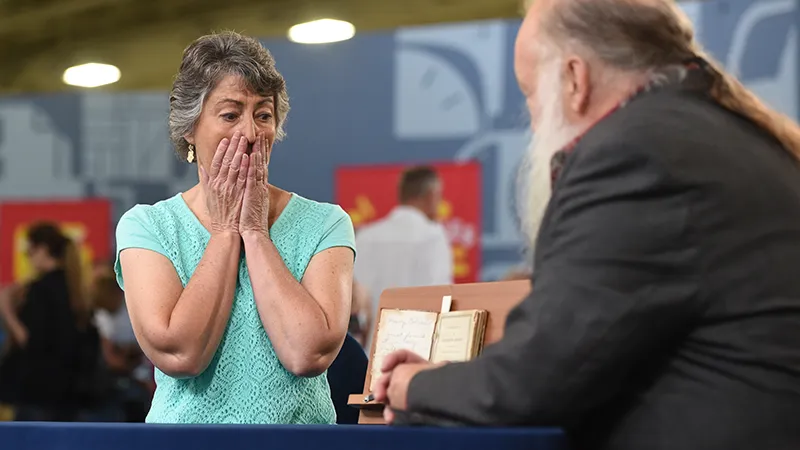GUEST: This ring came to me by way of my mother-in-law's death.
APPRAISER: Okay.
GUEST: And my husband received it in a velvet drawstring bag with a few other things. And we saw my mother-in-law wear it often, so we never saw it off to look at the back.
APPRAISER: Really look at it.
GUEST: To see if we knew anything about it.
APPRAISER: Okay.
GUEST: I wear it occasionally.
APPRAISER: Okay.
GUEST: And one time I had it to a jeweler just by chance because I was having my wedding bands replaced and repaired.
APPRAISER: Okay.
GUEST: And he pushed it away and said it's costume.
APPRAISER: Okay.
GUEST: And so I... I know nothing about it.
APPRAISER: And do you know where your mother-in-law got the ring?
GUEST: We have no idea.
APPRAISER: I'm glad that you wear it.
GUEST: Thank you.
APPRAISER: It's a lovely ring. And what's great about it is that strong green color, and do you know what that stone is?
GUEST: I assume it's an emerald.
APPRAISER: Right, and you're correct in assuming that. And what you want in a gemstone is that vibrant color. You want to see green from across the room when you wear it. And you have that here. What's great about it, beyond that, and interesting as well, is that it's actually foil-backed, pretty much. This is a platinum backing, and that acts as a foil that really accentuates the light that comes through the green. So that makes it an even stronger and more vibrant color.
GUEST: I didn't know that.
APPRAISER: Yeah. The ring dates to the early 20th century. And we know that because surrounding the emerald are about 2.5 carats of antique-cut stones.
GUEST: Oh, my.
APPRAISER: The emerald itself is just under 20 carats.
GUEST: You're kidding me.
APPRAISER: Right. Because most emeralds are heavily included, and this emerald is included. Even though it has that great strong green color, whoever cut this stone made the decision to not facet it. And it's been cut into a cabochon. The inclusions in the stone would have probably prohibited it from being a faceted stone, or an emerald cut, like we normally see.
GUEST: Interesting.
APPRAISER: It might be worth your while to look into finding out origin in this case. I believe that it's probably from Colombia.
GUEST: Oh.
APPRAISER: And you want your emeralds to be from Colombia. They're synonymous with that grass green color, that vibrant green...
GUEST: That is.
APPRAISER: ...that you see here. Beyond that, in terms of where it's made, it's unmarked. But I assume that it could either be American, or maybe even English. Many times emeralds are treated. They're likely normally oiled to enhance color. I would assume that this maybe has minor traditional oiling. But again, all of that would... we'd have to find that out from... from a certification...
GUEST: Did you say 20 carat?
APPRAISER: Just under 20 carats.
GUEST: My stars.
APPRAISER: Yeah, so it's quite a... quite a stone. If this were to come into auction, I would give it a conservative estimate somewhere in the neighborhood of $6,000 to $8,000.
GUEST: Oh, my stars! Oh!
APPRAISER: And I expect it could maybe do more.
GUEST: Oh, that's just amazing.
APPRAISER: Good.
GUEST: Costume, right?
APPRAISER: Yeah, not so much.
GUEST: That's just amazing, thank you.
APPRAISER: You're welcome.

